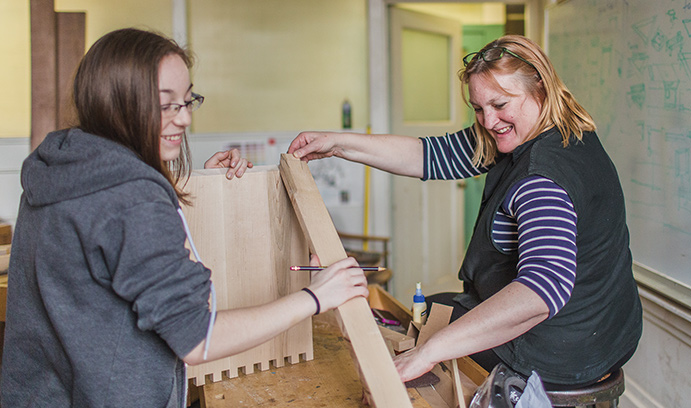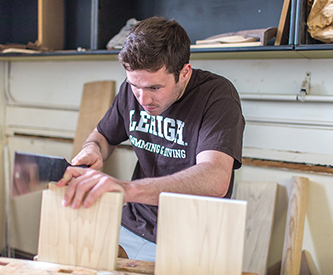Fashioning Furniture

Amy Forsyth, right, assists Ilana Abrams '18 with her final project.
If determination has a sound, it might be the pounding of a hammer, the scrape of a chisel or the repetitive scratch of a sander. Those are the noises that echo down the halls of Chandler-Ullmann from its first-floor woodshop and benchroom on a particular Tuesday in April.
If determination has a sound, it’s the soundtrack of Amy Forsyth’s furniture design class.
Most students in the class are studying architecture or product design. For their first assignment, students start with basswood. They create several designs, generating about 10 ideas and drawings and eventually settling on one, for which they first build a model. The semester begins with a carving project.
“Basically they start with a chunk of wood and they have to remove material, so it’s all about subtraction and shaping. They do it by hand,” said Forsyth, associate professor of design.
Past projects have included masks, candlesticks and walking sticks. This semester, each student hand-carved a spoon using tools like spokeshaves and files. Then, after learning how to fashion half-lap joints, mortise and tenons, and the more complicated hand-cut dovetail joints, students applied their skills to a second assignment: a display or stand for the spoon that incorporated at least one type of joint. The results ranged extensively in shape, size, design and composition, all concrete illustrations of creativity, skill and determination in mahogany, cherry, maple, bloodwood and, in some cases, a combination of several.
“As an architecture major I do get a lot of chances to make things with my hands, but they’re always kind of impermanent,” said Alex Adanski ’16 as she worked with a chisel to refine the joints on her final project, a chest on stand, which required a base with a separate structure on top. “They’re just models that I throw away. It’s really nice to be making something that I’ll have forever.”
“This class has been pretty great,” added Chris Campbell ’15, also an architecture student, whose final project is “more of a nightstand.” “I took [the course] because I really wanted something that I could make and keep and hold on to... I didn’t work in woodshop a whole lot in my past studios... so it’s been good to learn how to use a lot of these machines.”
“I build furniture myself,” said Forsyth, who began her career as an architect before discovering her love of furniture-making. “But [with this class] I also get to help a lot of people make a lot of really cool stuff. I could just do it myself, be by myself in my shop making it, but this way I get to influence a lot more things happening. It’s fun to see more projects happening and [students are] very enthusiastic about it, which is always really fun too.”
Posted on:


